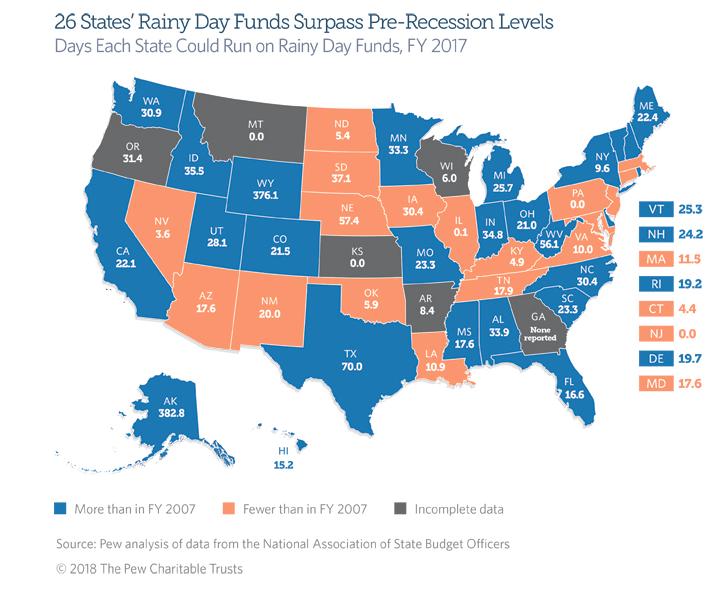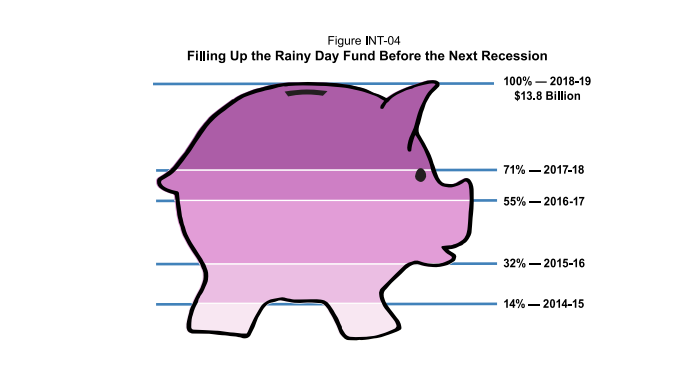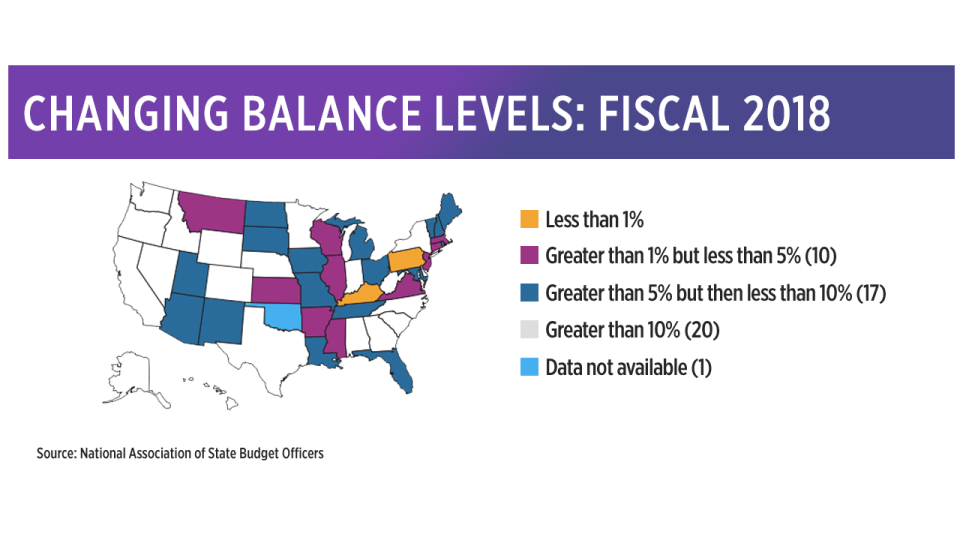Most states are prepared for the next recession
The collapse of Lehman Brothers a decade ago was a cataclysmic event that ushered in a financial crisis that would take over the country.
While some sectors, like housing, are still recovering, state governments have learned from the downturn and have built up their rainy day funds. So much so that they are well positioned to weather the next recession, which they know will occur. They just don’t know when.
“Rainy day fund balances, in the aggregate, grew steadily in the several years following the Great Recession, and have continued to increase as states have made building reserves a top budget priority,” according to the National Association of State Budget Officers.
In the past seven years, the median rainy day fund balance grew from 1.9% as a share of fund expenditures to a high of 5.8% in fiscal 2018, above the pre-recession peak of 4.9%, NASBO said, with 30 states reporting increases in fiscal 2018 (seven decreased).

The ‘perfect revenue storm’
The economic recovery in recent years enabled states to collect more tax revenue. According to NASBO’s Spring Fiscal Survey of States, 39 states were seeing fiscal 2018 revenues above projections; that figure is expected to be higher in the fall when data is available.
“Last year was a perfect storm of good news in the revenue side,” said Paul R. Kutasovic, professor of economics and finance at the New York Institute of Technology. “We now have a pretty good job market, income tax collection is strong, sales tax collection is strong and property taxes are rebounding with housing prices and oil prices much higher.”
Texas had the nation’s largest rainy day fund. In fiscal 2017, the state’s rainy day fund balance was $10.3 billion, recovering from a 2009 balance of $6.7 billion. The state, which weathered Hurricane Harvey last year and an oil price crash in 2014, expects the fund to reach $11.9 billion by the end of fiscal 2019.
“Texas is continuing to put money away to make sure we have a rainy day fund the next downturn,” said Chris Bryan, director of communications for the Texas comptroller’s office. “Texas’s conservative economic leadership is a model to follow (in how to prepare a rainy day fund).”
Kutasovic said oil-producing states have a stronger incentive to hold bigger reserves than others because of the high volatility of their revenue source, which is pegged to oil prices. “They have to put more aside in case oil prices go down again,” he said.
Meanwhile, California, also has an impressive rainy day fund. California has been basking in its longest stretch of balanced budgets these past six years, which has enabled Gov. Jerry Brown to prioritize saving for a rainy day. Credit-rating agency Moody’s Investors Service has a Aa3 rating on California with a positive outlook, a high-quality rating recently upgraded in part because of the actions the governor and legislature took.
“The next recession will be upon California soon enough, but a full rainy day fund and a commitment to prudent one-time spending are the best tools available to guide the state through it,” the state’s government said in a report.
In 2014, California voters passed legislation establishing a constitutional goal of reserving 10% of tax revenues in a rainy day fund by increasing deposits in years with high capital gains. The government made regular and supplemental deposits and now the fund is the largest in the country with nearly $14 billion.

Despite a perfect storm, some states aren’t in as good a position as others to confront an economic downturn. Pennsylvania and Kentucky, for example, have less than 1% of their total expenditures in a rainy day fund.
Mississippi is doing slightly better than Pennsylvania and Kentucky, but it just began to catch up to states like California and Texas. Mississippi plans to grow its rainy day fund to 7%, from 4.9%, of total expenditures by fiscal 2019. In 2017, Mississippi’s legislature passed the Financial and Operational Responses that Invigorate Future Years, or FORTIFY Act, which increased the percentage of the general fund that is allocated to the rainy day fund to 10%, from 7.5%. At that time the fund’s balance was $280 million, compared with the $311 million Mississippi had when the Great Recession’s effects were felt in 2009.
Raising a state’s rainy day fund to 10% of total expenditures is a trend Moody’s has seen across the country, according to Emily Raimes, a vice president and senior credit officer at Moody’s.
This month, Standard & Poor’s revised Mississippi’s credit rating from negative to stable because of the state’s recent approach to allocate resources where needed more effectively. Mississippi has an Aa2 rating (one notch below the average states’ ratings) with a negative outlook. Raimes said in the past couple years the state had underperforming revenues, midyear budget gaps and other fiscal challenges that resulted in the Aa2 rating.

States have an incentive to be ready
The Great Recession wasn’t the only thing that motivated states to get ready for the next downturn. Credit-rating agencies are paying attention to states’ finances. S&P, Fitch Ratings and Moody’s rate the creditworthiness of states and those ratings can mean the difference between a higher or lower cost of repaying bonds that states sell to finance infrastructure projects, according to a Pew Charitable Trust report.
Raimes explained that Moody’s takes a holistic approach to assessing credit, and rainy day funds are just one aspect of it. Although rainy day funds matter, Raimes said states can have liquidity and fund balances even without a dedicated rainy day fund. “States have different ways of setting money aside like raising revenues, cut spending and cut other programs,” she said.
Colorado, Illinois and Montana are the only states without dedicated rainy day funds, but their stories are different. Colorado has an investment grade Aa1 rating with a stable outlook due to a strong economy, higher-than-average income levels, and low relative debt. Montana has the same rating as Colorado. Meanwhile, Illinois has a Baa3 stable rating, below investment grade, with a stable outlook. Moody’s found that despite Illinois’s credit and strong power over revenue and spending, the state’s weak governance and policy-making framework, growing long-term pension liabilities and spiraling fixed costs makes investing in its debt instruments risky.
“A state with a healthy reserve, low volatility and high flexibility will be much better prepared to weather a recession and most states will have most of those,” said Raimes. “Half the states have more money in reserve than they had in the last peak cycle (2007).”
Texas is on the top with a Aaa rating and stable outlook because Moody’s analysts believe policymakers are experienced in dealing with the volatility. “In a recent assessment of how the four most populous states could weather the next recession, Moody’s found Texas better prepared than California, Florida, and New York, in part because Texas’s rainy day fund ‘provides substantially higher’ coverage of a budget shortfall than the other three states — three times’ coverage of a first-year deficit,” said the Pew report.
Warning signs
Kutasovic urges states to be conservative in forecasting revenues for 2019-20 budgets and beyond. The economy is heating up fast, having reached 4.2% GDP growth in the second quarter and the Federal Reserve is expected to hike interest rates to mitigate inflationary pressures. Kutasovic said once rates begin to rise, weak sectors of the economy will start to falter.
“We put in safeguards but we don’t know if they’ll work,” he said.
Maylan Studart is a reporter for Yahoo Finance
Read more from Maylan
5 things you need to know about the hottest weed stock
This brain cancer drug stock has been on a tear

 Yahoo Finance
Yahoo Finance 

